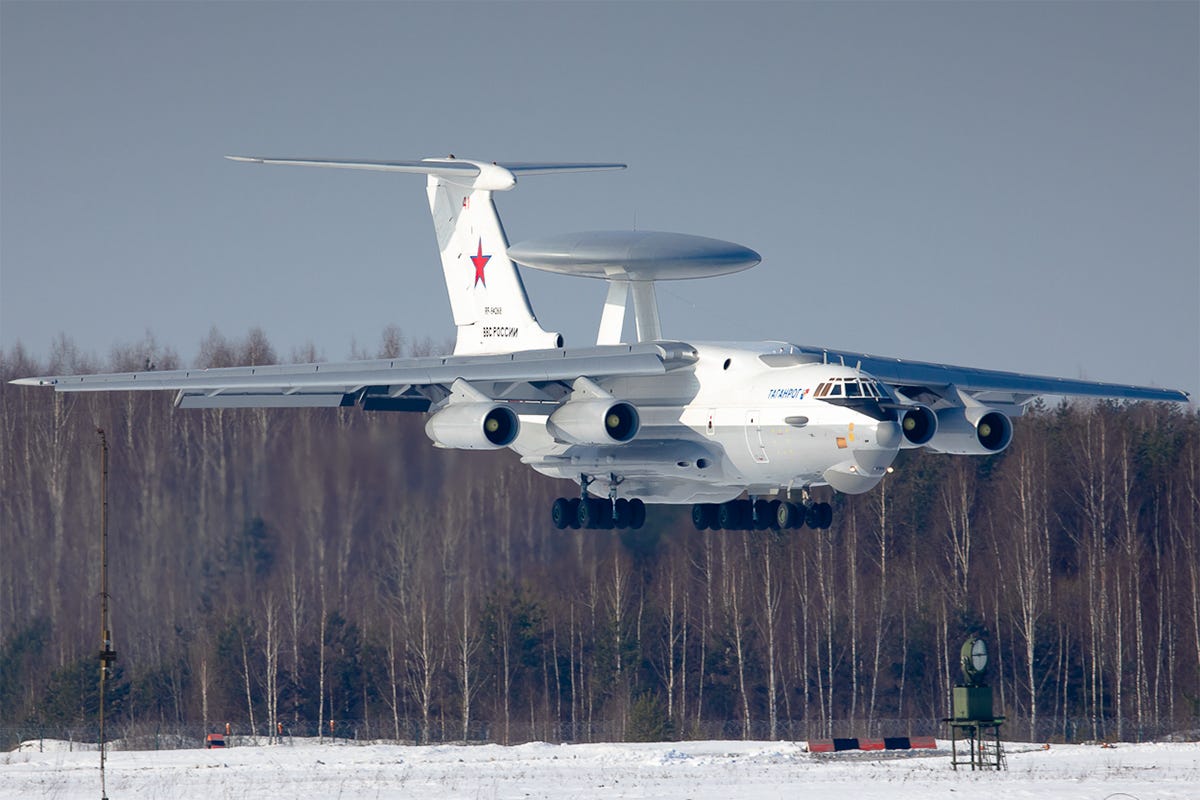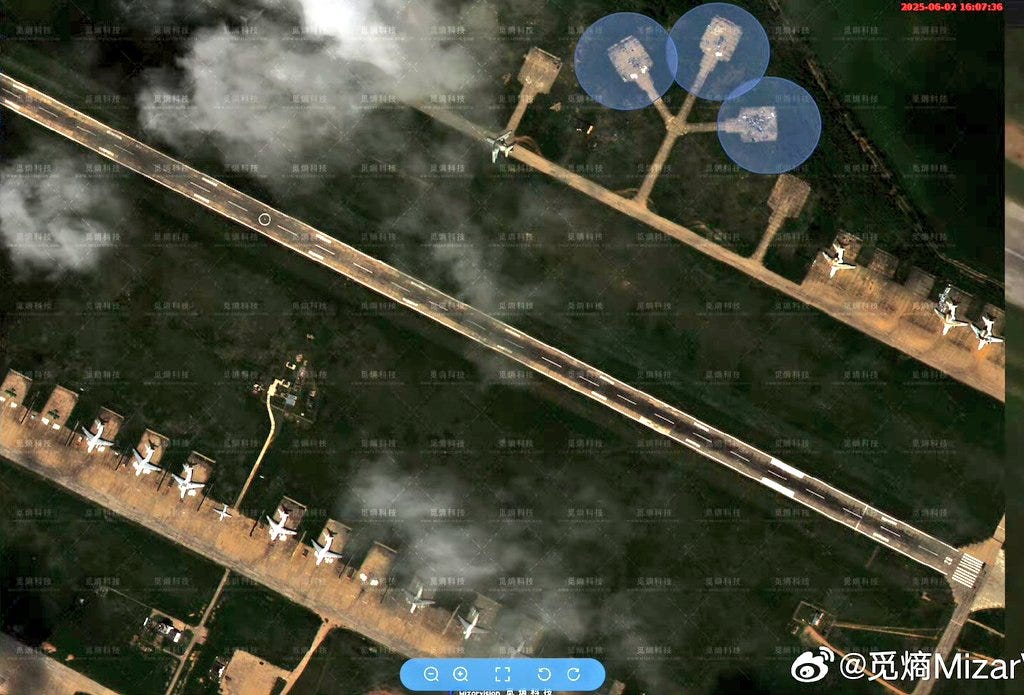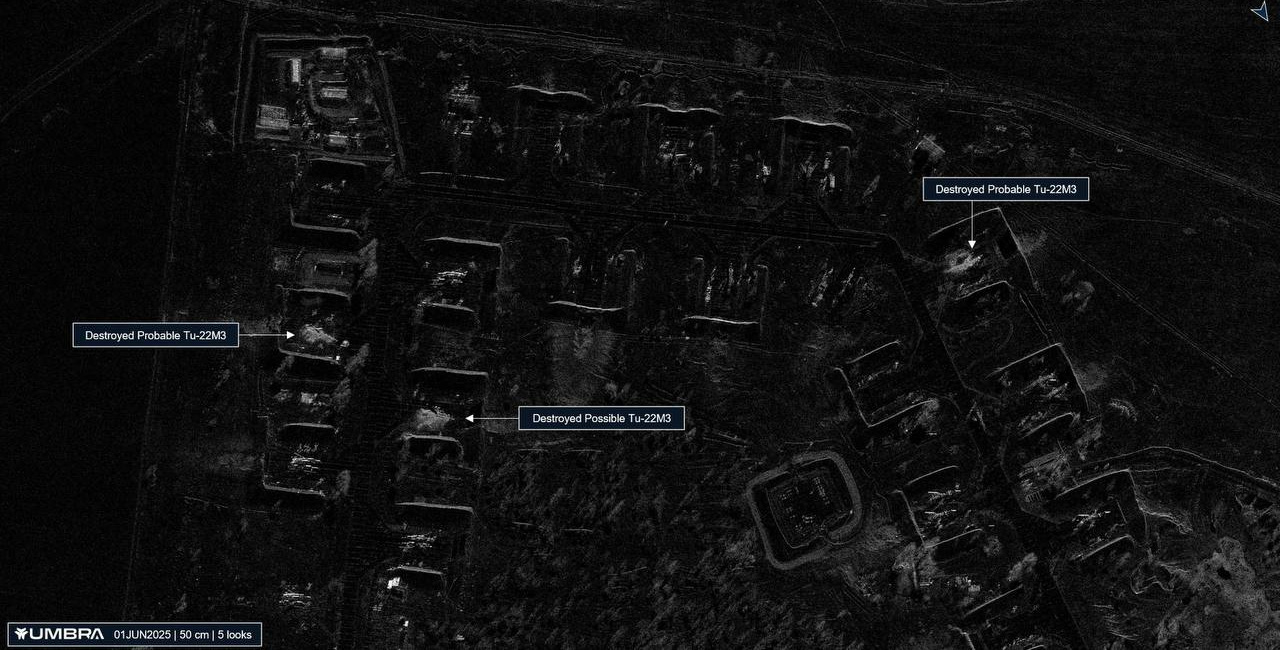
The Russian air force began Russia’s wider war on Ukraine in February 2022 with nine active Beriev A-50sM/Us—four-engine Ilyushin Il-76 airlifters with radar radomes on their fuselages and stations for up to 15 crew and battle-managers.
After Sunday’s Operation Spider Web—coordinated strikes on as many as five Russian air force bases by short-range attack drones that the Ukrainian state security service (SBU) smuggled near the bases in hijacked long-haul trucks—the Russians may be down to just five A-50s. Perhaps fewer.
Post-raid satellite imagery of Ivanovo air base in Ivanovo Oblast, in Russia 470 miles from Ukraine, depicts at least one suspicious pile of wreckage as well as a possibly scorched A-50. It’s hard to assess the imagery, but it may point to one or more destroyed or damaged A-50.
Whether the affected A-50s were active jets is even harder to assess. The Russian air force stores derelict radar planes at Ivanovo air base, occasionally stripping spare parts from them to support the dwindling fleet of active A-50s.
The A-50 like the U.S. Air Force Boeing E-3 flies behind the front line in order to scan the horizon for enemy aircraft and missiles. Soaring high above the ground cover and capable of repositioning as needed, Russia’s A-50s have helped Russian commanders to keep an eye on the Ukrainian air force—and to detect, minutes in advance, incoming Ukrainian missiles and drones.
A Ukrainian drone damaged an A-50 on the ground in Belarus in February 2023. In January 2024, a long-range Ukrainian missile—reportedly a U.S.-made Patriot—shot down an A-50 over the Sea of Azov in southern Ukraine. Six weeks later in February 2024, another Ukrainian missile, an ex-Soviet S-200, blew up a third A-50 in the same area.
The Russian air force swiftly grounded its surviving A-50s and scrambled to replace the two or three lost planes. That meant cycling at least one older and possibly unflyable A-50—out of several dozen Beriev built in the 1980s—through Beriev’s Aviation Scientific and Technical Complex in the city of Taganrog, on the Azov Sea coast just 80 miles from the front line.
So of course the Ukrainians promptly droned the Taganrog factory the following month.
The Kremlin reportedly canceled the effort to replace the A-50 with newer A-100 radar planes earlier this year. The upshot is that, by this spring, the Russian air force may have been down to six or fewer active A-50s—with no clear plan for complementing or replacing them.
Drone swarm
And then, on Sunday, the SBU’s drones swarmed in. The SBU targeted Dyagilevo, Ivanovo, Olenya, Belaya and Ukrainka air bases—respectively 310, 470, 1,200, 2,700 and 3,700 miles from Ukraine—with more than 100 explosive quadcopters connected to their operators via Russia’s telecommunications network.
The drones meant for Ukrainka never launched. It’s unclear whether the attack on Dyagilevo succeeded, but signs point to no. We have video of the attacks on Olenya and Belaya, as well as post-strike imagery of Belaya and Ivanovo—and it seems all three bases were hit.
The SBU claimed it damaged as many as 40 Russian planes, in all. So far, it’s possible to confirm hits on seven Tupolev Tu-95 bombers, four Tupolev Tu-22M bombers and a single Antonov An-12 transport.
If the imagery of Ivanovo does indeed depict one or more damaged or destroyed A-50, the toll from Sunday’s raids could exceed 13 large warplanes—including at least 11 bombers out of a pre-raid bomber fleet numbering just 118.
The A-50 loss or losses could be the most impactful. The problem, for the Kremlin, is that it needs three early-warning orbits in order to cover the entire 700-mile front line in Ukraine: one each in the south, east and north.
It takes at least nine A-50s to support three orbits: one plane is on station, another is returning to base and a third is in maintenance. In fact, the Russian air force would need additional jets to support crew training and to provide a float for periodic depot work.
It may yet be possible for the Russian air force to sustain a single A-50 orbit. But two is unlikely—and three is now impossible. With each A-50 the Ukrainians have destroyed, Russia’s aerial radar coverage over the front line has shrunk.
For Ukraine, it’s a beneficial cycle. Less Russian radar coverage means more opportunities for Ukrainian forces to slip missiles or drones through Russian air-defenses in order to inflict even more damage—including damage to ground-based radars.
Those attacks in turn further fragment Russia’s early-warning network … and help even more subsequent attacks get through.
Read more:
The Russian Air Force May Be Down to 52 Flyable Tu-22Ms
The first post-strike satellite imagery is beginning to appear online a day after the Ukrainian security service, or SBU, staged a devastating drone raid on air bases across Russia.






